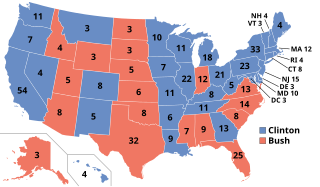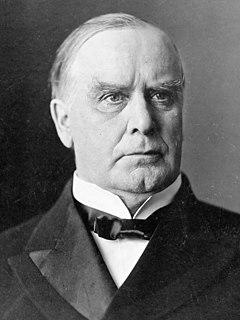
The 1992 United States presidential election was the 52nd quadrennial presidential election, held on Tuesday, November 3, 1992. Democratic Governor Bill Clinton of Arkansas defeated incumbent Republican President George H. W. Bush, independent businessman Ross Perot of Texas, and a number of minor candidates. The election marked the end of a period of Republican dominance in American politics that began in 1968, and also marked the end of 12 years of Republican rule of the White House. Until 2020, this would the last time in which the incumbent president failed to win a second term.

The 1848 United States presidential election was the 16th quadrennial presidential election, held on Tuesday, November 7, 1848. In the aftermath of the Mexican–American War, General Zachary Taylor of the Whig Party defeated Senator Lewis Cass of the Democratic Party.

The 1852 United States presidential election was the 17th quadrennial presidential election, held on Tuesday, November 2, 1852. Democrat Franklin Pierce, a former senator from New Hampshire, defeated Whig nominee General Winfield Scott.

The 1856 United States presidential election was the 18th quadrennial presidential election, held on Tuesday, November 4, 1856. In a three-way election, Democrat James Buchanan defeated Republican nominee John C. Frémont and Know Nothing nominee and former President Millard Fillmore.

The 1872 United States presidential election was the 22nd quadrennial presidential election, held on Tuesday, November 5, 1872. Despite a split in the Republican Party, incumbent President Ulysses S. Grant defeated Democratic-endorsed Liberal Republican nominee Horace Greeley.

The 1900 United States presidential election was the 29th quadrennial presidential election, held on Tuesday, November 6, 1900. In a re-match of the 1896 race, incumbent Republican President William McKinley defeated his Democratic challenger, William Jennings Bryan. McKinley's victory made him the first president to win a consecutive re-election since Ulysses S. Grant had accomplished the same feat in 1872, Until 1956, this would be the last time in which an incumbent Republican president would win re-election after serving a full term in office. This election saw the fifth rematch in presidential history, something that would not occur again until 1956. This was also the first rematch to produce the same winner both times.

The 1932 United States presidential election was the 37th quadrennial presidential election, held on Tuesday, November 8, 1932. The election took place against the backdrop of the Great Depression. Incumbent Republican President Herbert Hoover was defeated in a landslide by Democrat Franklin D. Roosevelt, the Governor of New York and the vice presidential nominee of the 1920 presidential election. Roosevelt was the first Democrat in 80 years to win an outright majority in the popular and electoral votes, the last one being Franklin Pierce in 1852. Hoover was the last incumbent president to lose reelection until Gerald Ford lost 44 years later. The election marked the effective end of the Fourth Party System, which had been dominated by Republicans.

The 1972 United States presidential election was the 47th quadrennial presidential election. It was held on Tuesday, November 7, 1972. Incumbent Republican President Richard Nixon from California defeated Democratic U.S. Senator George McGovern of South Dakota. Until the 1984 election, this was the largest margin of victory in the Electoral College in a U.S. presidential election, and as of 2022, it remains the last time a presidential candidate captured more than 60% of the popular vote. It was also the first presidential election that would see California move ahead of New York in each state's number of electoral votes, a gap that has since widened.

The Green Mountain Peace and Justice Party, known as the Liberty Union Party(LUP) until 2021, is a political party active in the U.S. state of Vermont. It is a self-proclaimed "non-violent socialist party".
The Progressive Party was a political party created as a vehicle for Robert M. La Follette, Sr. to run for president in the 1924 election. It did not run candidates for other offices, and it disappeared after the election. The party advocated progressive positions such as government ownership of railroads and electric utilities, cheap credit for farmers, the outlawing of child labor, stronger laws to help labor unions, more protection of civil liberties, an end to American imperialism in Latin America, and a referendum before any president could lead the nation into war.
Willa Kenoyer was the Socialist Party USA (SPUSA) candidate for President of the United States in the 1988 U.S. presidential election. The SPUSA was not on the ballot in 1984 due to a lack of interest among its members, and only hoped for a vote total of five digits, expecting to do better in the next century, according to the chair Anne Rosenhaft. Kenoyer's running mate was Ron Ehrenreich; they also ran on the Liberty Union Party (LUP) line in Vermont, defeating Herbert G. Lewin of the Internationalist Workers Party by a vote difference of 199–66 in the LUP primary, which socialists use to gauge the relative strength of their campaigns. They hoped to spread their ideas, finding some similarities to the goals of Jesse Jackson's campaign, with significant differences regarding the military and intelligence agencies, and faulted him for, in their opinion, attracting more people to the Democratic Party. The Democratic party's ultimate nominee Michael Dukakis and platform were criticized by the campaign.
Mary Cal Hollis is an American activist. She was a third-party candidate for President of the United States in the 1996 U.S. presidential election, representing the Socialist Party USA (SPUSA) with running mate Eric Chester. Hollis and Chester also received the endorsement and ballot line of Vermont's Liberty Union Party, receiving 674 votes (80.1%) in their primary. Hollis appeared on the syndicated radio program Democracy Now! with two other socialist presidential candidates for a discussion and debate. The SPUSA ticket received 4,765 votes in the general election.

Gloria Estela La Riva is an American perennial political candidate, and communist activist with the Party for Socialism and Liberation (PSL) and the Peace and Freedom Party. She was the PSL's nominee and the Peace and Freedom's nominee in the 2020 presidential election, her tenth consecutive candidacy as either a presidential or vice presidential candidate. She was previously a member of the Workers World Party. She ran as the PSL's and the Peace and Freedom Party's presidential candidate in the 2016 presidential election, with Eugene Puryear and Dennis J. Banks as her running mates respectively. She was the PSL's presidential nominee in the 2008 presidential election. For the 2020 election, Sunil Freeman was her running mate.
This article contains lists of official and potential third party and independent candidates associated with the 1996 United States presidential election.

A general election was held in the U.S. state of Vermont on November 8, 2016. All of Vermont's executive officers were up for election as well as Vermont's Class III Senate seat and at-large seat in the United States House of Representatives. Primary elections were held on August 9, 2016.

A general election was held in the U.S. state of Vermont on November 6, 2018. All of Vermont's executive officers were up for election as well as Vermont's Class I Senate seat and at-large seat in the United States House of Representatives. Primary elections were held on August 14, 2018.











